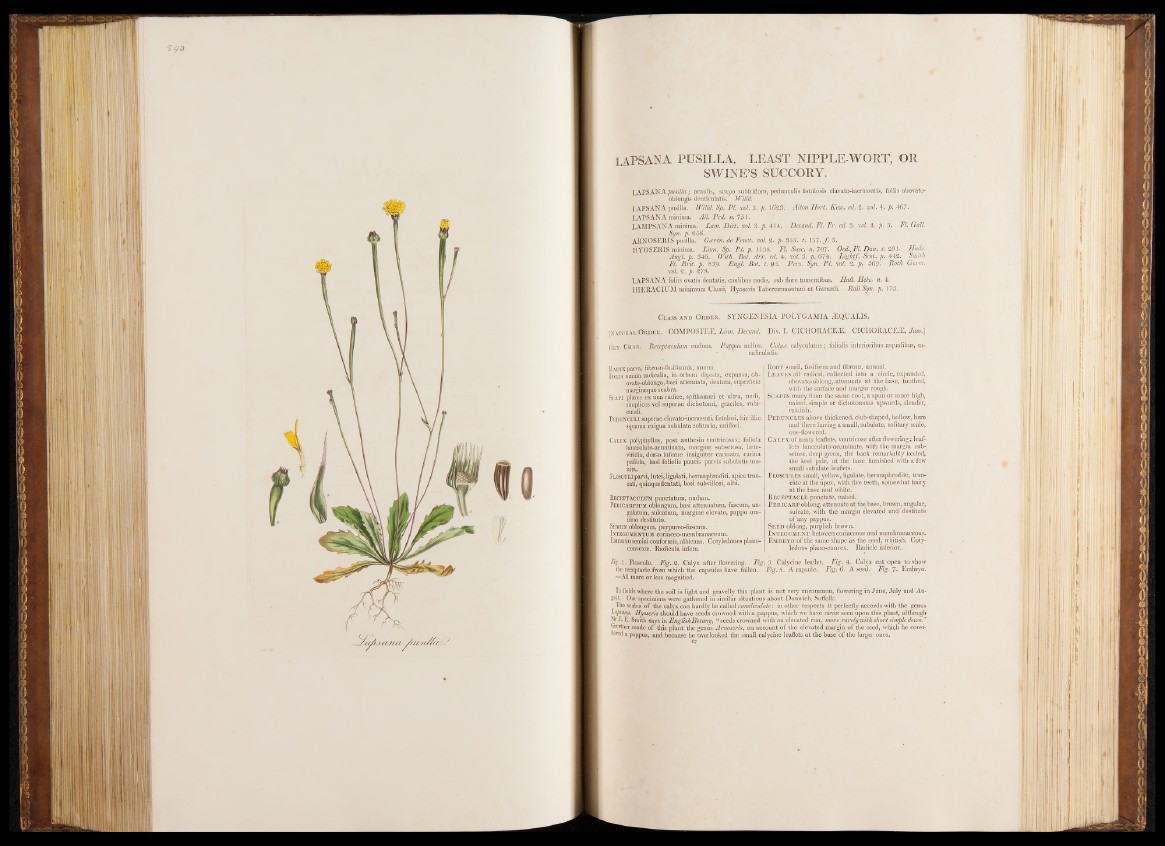
lapsana p u s il l a . l e a st n ip p l e w o r t , or
SWINE’S SUCCORY.
LAPSANA pusilla; acaulis, scapo subtrifloro, pedunculis fistulosis clavato-incrassatis, foliis obovato-
oblongis denticulatis. Willd.
LAPSANA pusilla. Willd. Sp. PI. ml. 3. p. 1623. .Alton Hort. Kew. ed. 2. ml. 4. p. 467.
LAPSANA minima. All. Ped. n. 7 5 1.
LAMPSANA minima. Lam. Diet. ml. 3. p. 414. Decand. FI. Fr. ed. 3. ml. 4. p . 3. FI. Gall.
Syn. p. 256.
ARNOSERIS pusilla. ' Gartn. de Fruct. ml, 2. p. 355. t. 157. f . S.
HYOSERIS minima. Linn. Sp. P l. p. 1138. FI. Suec. n. 707. Oed.,Fl. Dan. t. 201. Huds.
Angl. p. 346. With. Bot. Arr. ed. 4. ml. 3. p. 674. Lightf. Scot. p. 442. Smith
FI. Brit. p . 839- Engl. Bot. t. 95. Pet's. Syn. PI. ml. 2. p. 369. Both Germ,
ml. 2. p. 278. .
LAPSANA foliis ovatis dentatis, caulibus nudis, sub flore tumentibus. Hall. Helv. n. 4.
HIERACIUM minimum Clusii, Hyoseris Tabernajmontani et Gerardi. Rail Syn. p. 173.
Class and Ord e r . SYNGENESIA POLYGAMIA iEQUALIS.
[Natural Order. COMPOSITIE, Linn. Decand. Div. I. CICHORACEiE. CICHORACE/E, «/wjs.]
Gen. Char. Receptaculum nudum. Pappus nullus. Calyx calyculatus; foliolis interioribus aequalibus, ca-
• • ‘ - naliculatis.
Radix parva, fibroso-fusiformis, annua.
Folia omnia radicälia, in orbem digesta, expansa, ob-
ovato-oblonga, basi attenuata, dentata, superficie
margineque scabra.
Sgapi pliares .ex una radios, spithammi et ultra, nudi,
simplices vei superne dichotomi, gräciles, rubi-
-cundi.
Pedunculi superne elavato-incrassati, fistulosi, hie illic
squama exigua subulata solitaria, uniflori.
Calyx polyphyllus, post anthesin ventricosus; foliola
lanceolato-acuminata, margine subsetosa, Ifete-
viridia, dorso inferne insigniter carinato, Carina
pallida, basi foliolis paucis parvis subulatis mu-
nita,
Flosculi parvi, lutei, ligulati, hermaphroditi, apice trun-
cati, quinquedentati, basi subvillosi, albi.
Receptaculum punctatum, nudum.
Pericarpium oblongum, basi attenuatum, fuscum, an-
gulatum, sulcatum, margine elevato, pappo om-
nino destitute.
Semen oblongum, purpureo-fuscum.
Integumentum coriaceo-membranaceum.
Embryo semini conformis, albicans. Cotyledones planoconvex
». Radicula infera.
Root small, fusiform and fibrous, annual.
L eaves all radical, collected into a circle, expanded,
obovato-oblong, attenuate a t the base, toothed,
with the surface and margin rough.
Scapes many from the same root, a span or more high,
naked, simple or dichotomous upwards, slender,
reddish.
Peduncles above thickened, club-shaped, hollow, here
and there, having a small, subulate, solitary scale,
one-flowered.
Calyx o f many leaflets, ventricose after flowering; leaf-
. lets lanceolato-acuminate, with the margin sub-
setose, deep green, the back remarkably keeled,
the keel pale, at the base furnished with a few
small subulate leaflets.
Floscules small, yellow, ligulate, hermaphrodite, truncate
at the apex, with five teeth, somewhat hairy
at the base and white.
R eceptacle punctate, naked.
Pe r ica rp oblong, attenuate at the_ base, brown, angular,
sulcate, with the margin elevated and destitute
of any pappus.
Se ed oblong, purplish brown.
I ntegument between coriaceous and membranaceous.
Embryo of the same shape as the seed, whitish. Cotyledons
plano-convex. Radicle inferipr.
Fig. 1. Floscule. Fig. 2. Calyx after flowering. Fig. 3. Calycine leaflet. Fig. 4. Calyx cut open to show
the receptacle from which the capsules have fallen. Fig. 5. A capsule. Fig. 6. A seed. Fig. 7. Embryo.
'—All more or less magnified.
In fields where the soil is light and gravelly this plant is not very uncommon, flowering in June, July and August.’
Our specimens were gathered in similar situations about Dunwich, Suffolk.
The scales of the calyx can hardly be called canaliculate: in other respects it perfectly accords with the genus
Lapsana. Hyoseris should have seeds crowned with a pappus, which we have never seen upon this plant, although
Sir J. E. Smith says in EnglishBotany, “seeds crowned with an elevated rim, more rarely with short simple down.”
Gartner made of this plant the genus Arnoseris, on account of the elevated margin of the seed, which he considered
a pappus, and because he overlooked the small calycine leaflets at the base of the larger ones.